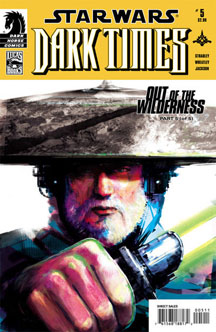After a couple of arcs focusing on the Uhumele crew, author Randy Stradley and artist Douglas Wheatley return to Jedi Dass Jennir – who went his own way after Issue 5 – for the next two arcs in “Dark Times.” As a means of catching readers up with Jennir, Issue 0 is the first issue of “Blue Harvest,” which continues in Issues 13-17 (2009-10). Jennir’s adventures then move directly into “Out of the Wilderness,” Issues 18-22 (2011-12).
Stradley (who goes by the pen name Mick Harrison on “Blue Harvest” but then begins to use his real name on “Wilderness”) gives Jennir traits of both of the other main characters in the ongoing “Star Wars” titles: As a Padawan, Jennir was considered to be not very strong in the Force by his master (similar to Zayne Carrick in “Knights of the Old Republic”), and he has the ability to heal others with the Force (like Cade Skywalker in “Legacy”).
Still, Jennir distinguishes himself. So far, there’s been no talk of Jennir tapping into the dark side to heal people, a constant worry of Cade’s companions. And I think we’re told about his weak Force skills so we don’t mistake him with Superman. Rather, Jennir is the Jedi equivalent of “24’s” Jack Bauer: He’s a man of high moral character and surprising wells of physical stamina who does what needs to be done for the good of the masses – all by himself, if necessary. And, like Jack, the more bad guys Jennir kills, the less he chastises himself for it; while he becomes hardened, he doesn’t become dark.
In need of a job, Jennir comes upon a war between slavers and spicers who are terrorizing a community on Telerath, and so he wipes them all out. “Blue Harvest,” of course, was the fake movie title used to keep fans away from the California/Arizona desert set of “Return of the Jedi.” It was also the name of an “Ewoks” episode, for no apparent reason, and a 1990s “Star Wars” fanzine. Joe Schreiber’s 2010 “Star Wars” horror novel “Red Harvest” riffed on the title while also referencing the book’s bloody swath of violence. “Dark Times’ ” “Blue Harvest” has a similar meaning: The slavers are Chagrians and the spicers are T’surr; both species are blue-skinned and have blue blood.
Due to Wheatley’s deliberate pace, more than a year passed before “Out of the Wilderness” hit the shelves. But, as always, it was worth the wait. While he might not be every fans’ No. 1 favorite artist, there’s no denying he’s the best visual storyteller among “Star Wars” artists, almost to the point where he deserves a co-credit with Stradley. When the Uhumele crew lands on Telerath in Jennir’s wake, we can see from a glance at the backgrounds that it’s a more peaceful place thanks to Jennir’s efforts. A more mundane example of Wheatley’s attention to detail is that the length of Jennir’s facial hair reflects his access to shaving equipment. And a sadder example comes with each time we check in on Janks, the former Uhumele member who is almost literally rotting away in an Imperial prison cell.

The consummate hero, Jennir doesn’t just wipe out the bad guys on Telerath, he also takes one of the borderline baddies with him, knowing she will not survive long now that there’s been a changing of the guard. Ember ran a hotel/brothel/safehouse where she used slaves rather than employees, and she regularly berated them. Why did Jennir bring Ember with him? “I didn’t have much of a choice, Ember. They would’ve lynched you if I’d left you there.”
As they trek across the desert wastelands of Prine – having been shot down by Imperials – Ember is like Princess Vespa from “Spaceballs.” She whines the whole time, and it’s remarkable that Jennir’s droid H2 is only lugging essential water and supplies rather than Ember’s complete set of luggage. By the end of “Wildnerness,” though, Jennir and Ember share a mutual kiss. It’s surprising, but I’ll let Stradley and Wheatley get away with it. Ember does turn over a new leaf amid the adventure when she demands that Jennir save a young girl from a slaver caravan rather than herself.
When Jennir and the Uhumele crew meet up again, Ember becomes the newest member of the group. In an example of one of the many details that make “Dark Times” such a rich text, Ember dips into the wardrobe of Crys (who died in “Vector”), and Ratty – who apparently knows his way around a spool and thread (!) – says he’ll adjust the dress for a better fit.
As a side plot through these issues, Darth Vader is a couple steps behind Jennir, despite Palpatine’s orders that he not go after surviving Jedi (although if he encounters one by chance, he is allowed to make the kill). “I have a plan in place for dealing with their remnant,” the Emperor says. I wonder if Palpatine wants to establish a cadre of dark-side adepts and inquisitors. Perhaps he intends to capture rather than kill the Force-users the Empire comes across, and try to mold them to his needs. We see several Imperial dark-siders in future stories – Starkiller, Mara Jade, various inquisitors (most recently, the Inquisitor from “Rebels”) – so it would be neat to get an explanation of how Palpatine finds and shapes these people.

